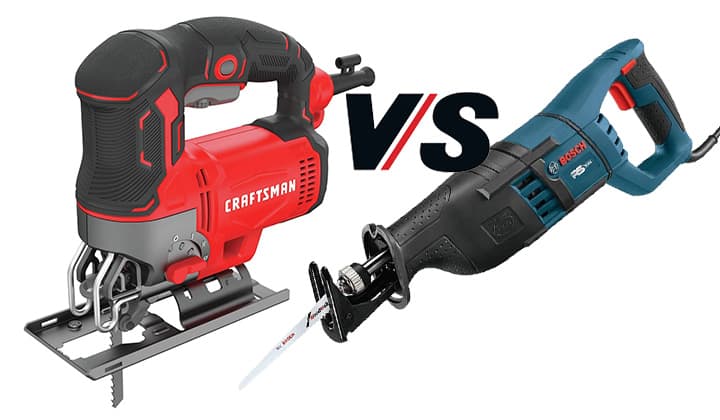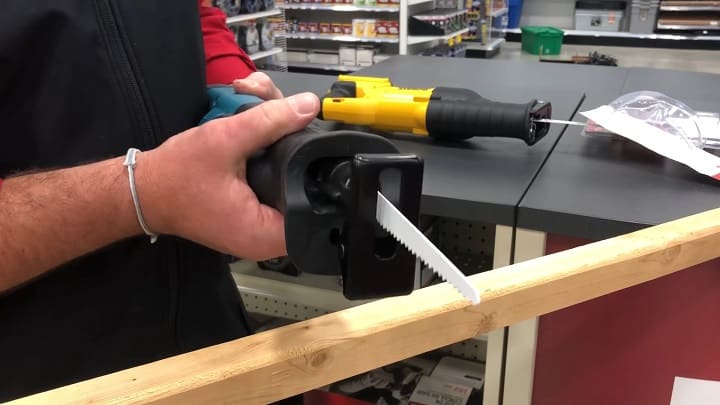For tasks such as home renovations, remodeling structures, small projects, or even demolition, you might have thought of getting a jigsaw or a reciprocating saw. Both the jigsaw and reciprocating saw are useful tools for professional usage or personal purposes.

A jigsaw has its blade positioned vertically, whereas a reciprocating saw has a horizontal blade. Both saws can be used for cutting through various materials. If you were wondering what differentiates them, read this article to know in brief about jigsaw vs reciprocating saw.
In this post we'll cover:
What Is a Jigsaw?
Jigsaws (like these) are a great choice for precision cutting. It can complete a job with more finesse than most saws due to its small and thin blade nature. It is also achieved because jigsaw blades function with up and down movement.
The blade of a jigsaw can be replaced, and there are several options to choose from. Jigsaws are primarily used for intricate cuts, such as beveling, curved cuts, and plunge and cross-cutting. It is not only used for cutting wood; it can cut through ceramic tiles, metal, and plastic.
What Is a Reciprocating Saw?
The design of the reciprocating saw has been derived from the basic hacksaw. There are various uses for a reciprocating saw. It can be used to cut various materials such as metal, wood, fiberglass, and ceramic.

Reciprocating saws are very powerful and are often preferred for heavy-duty purposes. The blade of these saws functions in a back and forth manner. It is usually a few inches long, and there are various types available.
These saws are useful for projects that require immense cutting power to rip through the material at hand.
Pros and Cons of Jigsaw
Although jigsaws are a handy tool for metal and woodworking, there are some drawbacks that you need to consider before buying.
Pros
- Best suited for jobs that require precise cutting such as beveling, curved cuts, plunge, and cross cutting
- Versatile tool as it can be used not just for wood, but also for ceramic tiles, metal, plywood, and plastic
- Unlike reciprocating saws, jigsaws can complete tasks with more finesse
- Easy to use – can be used for home projects and by DIY artists
- Safer than reciprocating saws
Cons
- It cannot be used for heavy-duty purposes
- Does not give the best results for flush cuts
- Not very easy to use for jobs that require cutting in high-up positions
Pros and Cons of Reciprocating Saw
If your projects need a reciprocating saw, here’s a list of benefits and disadvantages you will have to endure.
Pros
- Excellent tool for heavy-duty purposes such as demolition
- Very powerful and can rip through hard materials with ease
- Can cut both horizontally and vertically
- More of an all-in-one tool in comparison with jigsaws
- Better choice for outdoor projects
Cons
- Cannot be used for jobs that require precision and intricate cuts
- Finished product requires a lot of sanding as the surface remains rough
- Cannot cut irregular shapes and curves accurately
- May get very dangerous if not handled with caution
Conclusion
So, which one is the better choice between jigsaw vs reciprocating saw? As they are designed for different purposes, it is up to your requirements to decide on which is the best choice for you.
The key takeaway is — jigsaws are used for precision cutting, whereas reciprocating saws are used when immense cutting power is needed. Now that you have the insight needed, we wish you the best for your project.
I'm Joost Nusselder, the founder of Tools Doctor, content marketer, and dad. I love trying out new equipment, and together with my team I've been creating in-depth blog articles since 2016 to help loyal readers with tools & crafting tips.
